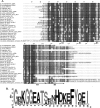In silico evidence for the horizontal transfer of gsiB, a σ(B)-regulated gene in gram-positive bacteria, to lactic acid bacteria
- PMID: 21421783
- PMCID: PMC3126443
- DOI: 10.1128/AEM.02569-10
In silico evidence for the horizontal transfer of gsiB, a σ(B)-regulated gene in gram-positive bacteria, to lactic acid bacteria
Abstract
gsiB, coding for glucose starvation-inducible protein B, is a characteristic member of the σ(Β) stress regulon of Bacillus subtilis and several other Gram-positive bacteria. Here we provide in silico evidence for the horizontal transfer of gsiB in lactic acid bacteria that are devoid of the σ(Β) factor.
Figures




References
-
- Anderson I., et al. 2005. Comparative genome analysis of Bacillus cereus group genomes with Bacillus subtilis. FEMS Microbiol. Lett. 250:175–184 - PubMed
-
- Anisimova M., Gascuel O. 2006. Approximate likelihood-ratio test for branches: a fast, accurate, and powerful alternative. Syst. Biol. 55:539–552 - PubMed
-
- Asteri I. A., et al. 2010. Characterization of pLAC1, a cryptic plasmid isolated from Lactobacillus acidipiscis and comparative analysis with its related plasmids. Int. J. Food Microbiol. 141:222–228 - PubMed
MeSH terms
Substances
LinkOut - more resources
Full Text Sources
Molecular Biology Databases

